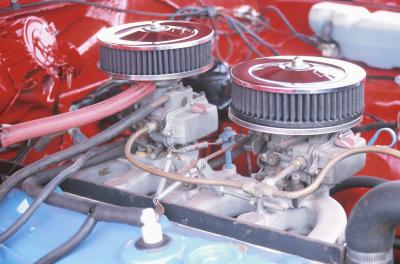
The carburetor spacer is something of an enigma in the world of hot-rodding. Spacers are cheap, fairly universal and use no moving parts, but they often boost power more than a number of parts costing many times as much. While testing and tuning is a vital component of the spacer selection process, they are usually cheap enough you could afford to buy a few and select the spacer -- or combination of spacers -- that work best for your engine.
A typical dual-plane intake manifold -- one with a vertical wall dividing the plenum chamber below the carb -- essentially turns a four-barrel carburetor into two two-barrels, and a two-barrel into a pair of single-barrels. This is generally a fine approach when it comes to maintaining engine vacuum and midrange torque, but it hinders horsepower by depriving the individual cylinders of a large reservoir of air. If you're willing to sacrifice a bit of torque for horsepower, you might as well turn the intake into a full single-plenum by cutting the plenum divider wall to half-height or removing it completely. In for a penny, in for a pound, they say.
Four-barrel carbs generally come with one of two bolt patters; either the standard "Holley"or AFB pattern, or the more spread-out Quadrajet. Carburetor spacers actually came about not as a means to boost performance but as adapters to fit non-stock carbs to stock manifolds. The spacer's performance benefits were something of a pleasant surprise. Many spacers come pre-drilled to accept either bolt pattern, so switching to a non-stock carburetor is no more difficult than reinstalling the stock fuel mixer.
Hot fuel vaporizes more quickly in the cylinder, which can be a boon in terms of fuel efficiency and operation in cold weather but a hindrance to performance. Hot fuel and hot carburetors increase intake air temperature, which decreases air and thus oxygen density. This is detrimental to horsepower, torque and fuel economy, which offsets any economy gains you might see running slightly warmer fuel. Cool fuel doesn't do much for cold-weather performance, but them's the breaks. Running a metal carb spacer will reduce fuel temperature by sole virtue of the second carburetor gasket, but fully insulating "phenolic" or plastic spacers will do the job even better.
Undersized plenums aren't uncommon, especially on emissions-era engines. This is usually a case of manufacturer cost-cutting, a practice pursued simply so the manufacturer could use the same intake on a 400-cubic-inch engine that they might on a 305. So follows bean-counter logic: Better to give up horsepower on an impractically large 400-cubic-inch motor than to cast a separate manifold for its three-quarter-scale cousin. Installing either an open or four-hole spacer will help to undo the manufacturer's cost-cutting, bringing plenum volume back up to where it should have been in the first place.
In most cases, a carburetor's round barrels terminate directly below the throttle plates, a practical approach, but not the best where fuel atomization is concerned. A four-hole spacer essentially acts like an extension of the carburetor barrel, lengthening it to increase air velocity through it. The net result is an increase in both total airflow through the carburetor and better fuel mixing when the droplets hit that faster-moving airstream. Additionally, most carb spacers have smooth edges instead of sharp corners, which further enhances airflow.